LNG America has named the American Bureau of Shipping (ABS) as the classification society for its LNG bunker barges, currently being designed by Jensen Maritime.
ABS will assist LNG America in working with shipbuilders and regulators in developing the first bunker barges for North America that meet or exceed all technical and regulatory requirements.
“We are pleased to be working with ABS on this important domestic initiative. ABS has watched ship propulsion move from wind to coal, from coal to oil, and now from oil to natural gas. They are well situated to help us usher in a new era of clean domestic fuel,” said Keith Meyer, president and CEO of LNG America.
ABS was the first provider of classification for the gas sector and 34 percent of LNG tankers under construction around the world are set for ABS class. ABS is also providing services to the largest and most advanced LNG fueled ships in the world.
“We are looking forward to working with LNG America on North America’s first LNG bunker barges. These units will be the first of many that will be required if our industry is going to support the transition to LNG as a fuel for the ships entering U.S. ports,” said Jim Watson, president and COO, ABS Americas. “LNG is an exciting sector for us, and we look forward to using our technical knowledge to support the growth of gas fuel for transportation here, and around the world.”
The LNG bunker vessels will provide a critical building block in the bridge between the natural gas industry and the global marine industry, and will allow the ship owners and charter parties to receive LNG as bunker fuel the same way they receive oil today, ABS said.
ABS is currently the third largest classification society in the world with 16.5 percent of the global fleet operating under ABS class and 24.3 percent of all new construction assets being built to the class society’s standards.
LNG America said its objective is to become a leader in distributing LNG to the high-horsepower fuel market, bringing value, experience and a ready supply source. Its "distributed LNG" program is designed to allow the environmental and economic benefits of natural gas in the form of LNG to gain appreciable market share in the marine and other high-horsepower fuel markets.




